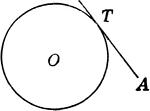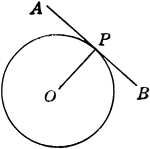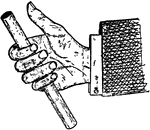
Right Hang Rule
"Right hand rule to determine the direction of magnetic field around a conductor carrying a current.…
!["Right hand rule for polarity of a solenoid: If the solenoid be grasped in the right hand, so that the fingers point in the direction in which the current is flowing in the wires, the thumb extended will point in the direction of the north pole [of the solenoid]." Hawkins, 1917](https://etc.usf.edu/clipart/35600/35671/rhrsole_35671_mth.gif)
Right Hand Rule, Solenoid
"Right hand rule for polarity of a solenoid: If the solenoid be grasped in the right hand, so that the…
!["Fleming's rule for direction of induced current. Extend the thumb, forefinger and middle finger of the right hand [as shown]. Place the hand [so that] the thumb will point in the direction in which the conductor moves, the forefinger in the direction of the lines of force (N to S), then will the middle finger point in the direction in which the induced current flows." -Hawkins, 1917](https://etc.usf.edu/clipart/35600/35677/induc_35677_mth.gif)
Right Hand Rule of Induced Current
"Fleming's rule for direction of induced current. Extend the thumb, forefinger and middle finger of…
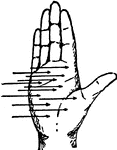
Right Hand Rule, Palm
"The palm rule for direction of induced current: If the palm of the right hand be held against the direction…

Simple Telegraph
"The electric telegraph in its simplest form, consists of an electric circuit connecting he points between…
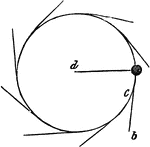
Centrifugal Force
"Suppose a cannon ball, tied with a string to the centre of a slab of smooth marble, and suppose an…
Center of Gravity
"The center of gravity, in any body or system of bodies is that point upon which the body, or system…

Center of Gravity
"In a body of equal thickness, as a board, or a slab of marble, but otherwise of an irregular shape,…
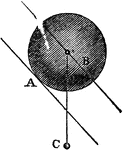
Center of Gravity of a Ball Rolling on an Incline
"If the plane is inclined downwards, the ball is instantly thrown into motion, because the centre of…

Center of Gravity of Standing Blocks
"Where five blocks are placed in this position, the point of gravity is near the centre of the thrd…
Center of Inertia
"But, suppose the same bar or iron, whose inertia was overcome by raising the centre, to have balls…

Single Movable Pulley
"In the single moveable pulley, the same rope passes from the fixed point, A, to the power, P. It is…
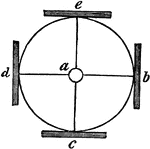
Sound Reflection in a Circle
"In a circle, sound is reflected from every plane surface placed around it, and hence, if the sound…
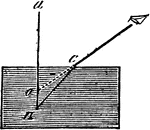
Refraction, water
"Suppose the rod a, to be set with one half of its length below the surface of the water and the other…

Rays of Light
"Rays of light are said to diverge, when they proceed from the same point, and constantly recede from…

Curved Image
"If the object a be placed obliquely before the convex mirror, then the converging rays from its two…
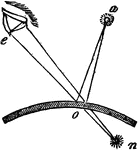
Convex Mirror
"Let us suppose that a, is a luminous point, from which a pencil of diverging rays falls upon a convex…
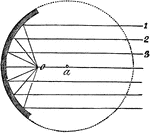
Focus of a Concave Mirror
"The focus of a concave mirror is the point where the rays are brought together by reflection." -Comstock…

Divergent Rays in a Concave Mirror
"...be made obvious...where the diverging rays 1, 2, 3, 4 form a focus at the point o, whereas, had…
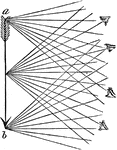
Pencils of Rays
"These pencils of rays not only flow from the points designated in the figure, but in the same manner…
Refracting Telescope
"Suppose a, to be a distinct object, from which pencils of rays flow from every point toward the object…

Electroscope
"One of the simplest instruments of this kind consists of a metallic needle, terminated at each end…
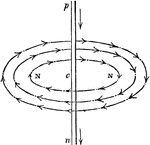
Circular Motion of the [Electric] Fluid
"Thus, if we suppose the conducting wire be placed in a vertical situation, as shown, and p, n, the…

Law of Reflected Motion
"The angle, ABD, included between the direction of the moving body before it strikes the reflecting…
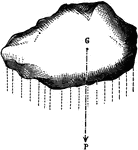
Center of Mass
"A body's center of mass is the point about which all matter composing the body may be balanced. It…
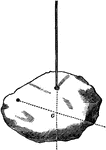
Finding the Center of Mass
"Let any irregularly shpaed body, as a stone or chair, be suspended so as to move freely. Drop a plumb…
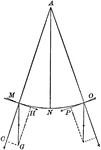
Motion of a Pendulum
"When the pendulum is drawn from its vertical position, the force of gravity, MG, is resolved into two…

Nicholson Hydrometer
"The Nicholson hydrometer of constant volume is a hollow cylinder carrying at its lower end a basket,…
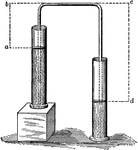
Siphon
"The vertical distance form the level of the upper liquid to the highest point of the tube (ab) is the…

Reflection of Sound Using a Reflector
"Hold a lamp reflector or other large concave mirror directly facing the sun, so as to bring the rays…
Sound Wave
"Lightly touch the wire at its middle point with the tip of the finger or the beard of a quill; the…
Constructive Interference
"Start a trough from A. At the moment of its reflection as a crest a B, start a crest at A as shown.…
Destructive Interference
"Using the rope...start a crest at A. At the moment of its reflection at B as a trough, start a second…
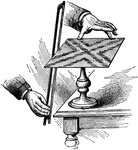
Vibrating Plates
"Support, as shown, a glass or brass plate, square or round, and strew it evenly with fine sand. Place…

Plane Mirror
"If an object is placed before a plane mirror, a virtual image appears behind the mirror. Each point…

Rays Diverging from Beyond the Center of Curvature on a Concave Mirror
"When the rays diverge from a point beyond the center of curvature, as B, the focus falls on the same…

Rays Diverging from Beyond the Center of Curvature on a Concave Mirror
"When the rays diverge form a point at a distance from the mirror less than that of the principal focus,…

Concave Mirror with Image and Focus
"The focus of each point chose may be determined by tracing two rays from the point, and locating their…
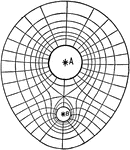
Equipotential Lines
"When a charge is moved from any point to another point in the same equipotential surface, no work is…
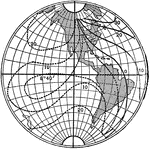
Isogonic Lines of Earth
"The magnetic poles of the earth do notc oincide with its geographical poles and, condequently, in some…
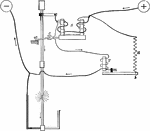
Detailed Arc Lamp
"Illustration showing the detail of a carbon arc lamp; S, solenoid; c, clutch; w, clutch-washer; T,…
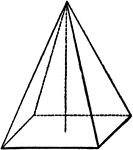
Pryamid
"A pyramid is a solid whose base is a polygon, and whose sides are triangles uniting at a common point,…
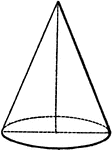
Cone
"A cone is a solid whose base is a circle and whose convex surface tapers uniformly to a point." —Hallock…
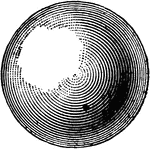
Sphere
"A sphere is a solid bounded by a uniformly curved surface, every point of which is equally distant…
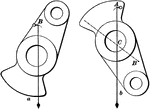
Center of Gravity of a Solid
"In a body free to move, the center of gravity will lie in a vertical plumb-line drawn through the point…

Lever
"The object W to be lifted is called the weight; the force is represented by P; the point, or pivot,…

Lever
"The object W to be lifted is called the weight; the force is represented by P; the point, or pivot,…
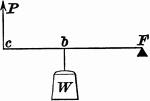
Lever
"The object W to be lifted is called the weight; the force is represented by P; the point, or pivot,…

Using a Screw to Raise Weight
"A screw is a cylinder with a helical proection winding around its circumference. This helix is called…

Lifting Pump
"In some cases it is desired to raise water higher than it can be forced by the pressure of the atmosphere…
!["At the freezing point [phosphorus] hardens, becomes brittle, and shows, on being broken, evidences of crystalline structure, the crystals being dodecahedral." —Hallock 1905](https://etc.usf.edu/clipart/36100/36184/phosphorus_36184_mth.gif)
Phosphorus
"At the freezing point [phosphorus] hardens, becomes brittle, and shows, on being broken, evidences…
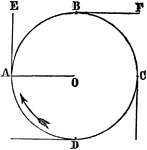
Centrifugal Force
"Attach a ball, for instance, to a cord; and , fastening the end of the cord at a point, O, give a quick…
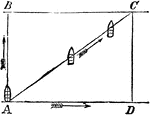
Resultant Motion with Boat
"We have an example of resultant motion in a boat which a person attempts to row north across a river,…
!["The part of the body in which the centre of gravity is situated, may be found, in some cases, by balancing it on a point. Thus the centre of gravity of the poker represented [here] lies directly over the point on which it is balanced." —Quackenbos 1859](https://etc.usf.edu/clipart/36300/36326/centergrav_36326_mth.gif)
Center of Gravity
"The part of the body in which the centre of gravity is situated, may be found, in some cases, by balancing…

Center of Gravity
"When such a surface is irregular in shape, suspend it at any point, so that it may move freely, and…
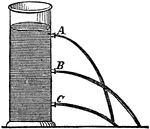
Course of Streams
"As the liquid flows out of each orifice, each stream follows a parabolic path based upon pressure of…

Light Intensity at Different Distances
"A card placed at point A receives normal light. At point B the card receives four times as much light,…
Diminish Shadow
"Since A is producing light and larger than object B, the shadow of B continuously shrinks to a single…
